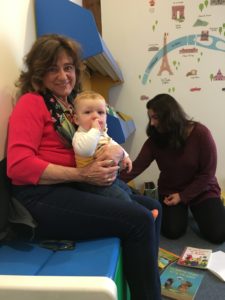Little Ari sits comfortably in his grandmother’s lap, sleepily tucking his blond head of hair into her arms. Josie, who is not much older than Ari, clings to her grandmother as she scuttles around the children’s room at the Alliance Française. Her cheeks flush a bright pink when Caroline Juneau greets her in French.
Juneau is at the helm of the AFLCR’s “Storytime for Kids,” held on the first Saturday of each month. During story time, she reads short books in French and leads the children in learning nursery rhymes and chants, like “Tête, épaules, genoux et pieds,” or “Head, Shoulders, Knees and Toes” in English.
“J’aime ta chemise, Josie,” Juneau says. Josie’s grandmother translates for her, and Josie sticks out her belly to proudly reveal a shirt that reads, “Chocolat, s’il vous plaît.” She knows very little French, but is catching on quickly. Ari is also rapidly picking up both French and English as the littlest member of a Québécois-American family.
“C’est étrange, c’est bizarre, non mais quel bazar !” Juneau’s voice bounds and pirouettes as she tells the tale of a little girl who finds a bear in her closet and a penguin in her bathtub among other wild discoveries. Josie and Ari giggle as Juneau flashes a picture of a large brown bear curled up on a shelf beneath the little girl’s dresses.
Juneau, a native of France, volunteers as story time lead at AFLCR in her free moments from her work as a French teacher at the Renaissance Elementary School in Shelburne. All of her work in teaching French to the children of our region comes after raising her three, now adult children in both French and English. When her children were growing up, she used to receive a lot of criticism about raising her children with two languages at once. “People told me I was crazy for raising my children bilingually,” she said. “If I spoke French to them, people would think that I was doing something bad for them – that it would delay their learning – but I was a more confident mom.”
Research even suggests that Juneau was onto something in raising her children as native bilinguals. According to studies conducted by Ellen Bialystok of Toronto’s York University and Fergus Craik of Toronto’s Rotman Research Institute of Baycrest, the positive implications for increased cognitive ability in bilinguals are glaring. In their 2010 publication for the Association for Psychological Science, titled, “Cognitive and Linguistic Processing in the Bilingual Mind,” they note that old misconceptions about slowed development in bilingual children can now be tossed out.
Bialystok and Craik found that, “the experience of speaking two languages on a regular basis has broad implications for cognitive ability, enhancing executive control functions across the life span.” Essentially, in all of their studies, bilinguals were able to outperform monolinguals of all walks of life on tasks that required them to use working memory, increased attention, conflict resolution skills, and others.
The benefits don’t just end at increased cognitive ability. According to their research, bilinguals of old age, on average, have delayed onset of dementia by about four years in comparison to their monolingual peers.
Adrienne Coléon Gaskell, AFLCR member and native bilingual can also attest to how her experience with two languages has become one of her greatest assets. Born to a French father and American mother, her experience was split between the two cultures. “Growing up in America, my parents raised me with a language and cultural fluency in French that has played a major role in my life,” she said. “I’ve enjoyed the freedom of picking and choosing which aspects of American or French culture suit me, and I am truly a mélange. It’s so much more than language; it’s a broader perspective. I am so grateful for this gift and delighted to pass it along to my own children.”
Coléon Gaskell is not the only member of the community who is currently raising her children to be both native French and English speakers. In fact, several other families, including those of Karina Perusse and Marielle Macias are doing just the same.
For the children of all three, each married to English and French-speaking American men, there are strict rules in place about what they can and cannot watch on TV. The Golden Rule? It must be in French. Their shared objective is to be able to support the French language as much as possible in the home when English is dominant outside of it.
Perusse, who is a native of Québec, likes to have Quebecois media present at home so that her three elementary-school-aged daughters can be exposed to the French language. “We have Canadian TV channels,” said Perusse. “It’s required that, if they are watching TV or movies, it is in French.” For her, it is important that her children understand her culture. “French is my native language,” she said. “We go to Québec every two months for a weekend and for holidays. My mom doesn’t speak English and I want my kids to be able to communicate with her.”
For Macias’ children, French is also the dominant language supported at home. “We have a book shelf with French books at the top and English books at the bottom,” she said. “They also like to listen to French music and at Christmastime they know all of the songs. The language is a part of our culture and it’s important that they are able to communicate.” She also mentioned that next year, her family may move to Marseilles in her native France. “They will be enrolled in French schools,” she said, noting the importance of the exposure the children are receiving now.
Macias also mentioned that one of the benefits of her children having the two languages is the ability for one language to support the other in school. “When my daughter has trouble spelling things in English, I can use French phonetics to help her,” she said.
Though being a native speaker of French has been helpful to her daughter academically in English, Macias notes that this is not necessarily her end goal in teaching her both languages. “At the end of the day, I’m not teaching her French so she can do better in school. It’s our culture and I want her to be able to communicate with her family in France.”
Despite even the best efforts and intentions, some challenges tend to arise when then children tend to prefer using one language over another. Coléon Gaskell notes that, in speaking with the parents of other bilingual families, she has observed that they tend to have some difficulties. “They often share that they have a tough time trying to get their kids to speak French with them,” she said.
This has been the case at times for Perusse, who says that when her children do not want to use French, it can leave her feeling isolated. “I get a lot of resistance to French, especially with the youngest,” she said. “They want to answer in English when I speak with them, but I want them to answer in French.”
While her children were growing up, Juneau said she used to hold bilingual playgroups at her home. “I remember, it was every Tuesday morning from 9-12,” she said. “It was a way for the bilingual parents and kids to come together and socialize. Otherwise, we would have been isolated.” For Juneau, keeping French strong in the greater social sphere is a driving force of hers, and part of the reason why she still leads AFLCR’s Storytime each month.
After Juneau finished reading to Josie and Ari, the two sprawled off on their own to investigate the troves of toys and French books in the children’s room. Josie’s little pink fingers plucked at the pages of one the picture books she discovered on the shelf. “Keeping French a social language is also very important,” said Juneau, watching Josie examine the treasure she found. “That way, it can continue to be shared. Plus, look how cute they are.”
Written by Emily Engott



